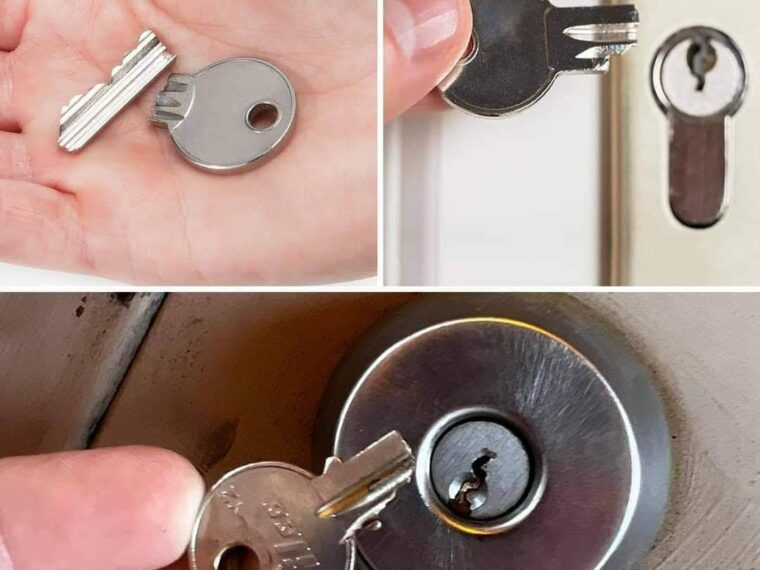Getting a key stuck in a lock can be frustrating and inconvenient, but don’t panic! You don’t always need to disassemble the lock or call a locksmith right away. With a bit of patience, the right tools, and careful techniques, you can often remove a broken key yourself. Let’s explore five effective tips to safely remove a broken key from a lock without causing additional damage.

Use Needle-Nose Pliers or Tweezers
One of the easiest ways to remove a broken key is to use a tool you likely already have at home—needle-nose pliers or tweezers.
- Locate the Key Fragment: If any part of the broken key is sticking out of the lock, you’re in luck. This visible fragment can be your saving grace.
- Grip Firmly but Gently: Use the pliers or tweezers to carefully grip the exposed part of the key. Avoid using excessive force, as this can push the fragment further into the lock.
- Pull Straight Out: Slowly pull the broken piece straight out. Twisting or jerking can worsen the situation by lodging the key deeper into the lock or damaging the locking mechanism.
This method works best when the broken key is sticking out far enough to grab, so inspect the lock closely before proceeding.
Apply Lubricant for Smooth Extraction
If the key fragment is stuck firmly or you’re having trouble pulling it out, applying a lubricant can make all the difference.
- Choose the Right Lubricant: Use a lock lubricant like WD-40 or graphite powder. These products reduce friction, making it easier to extract the key.
- Spray or Apply Carefully: Spray the lubricant directly into the keyhole. If you’re using graphite powder, gently puff it into the lock. Be careful not to overapply; a small amount goes a long way.
- Try Again with Tools: After applying lubricant, use pliers, tweezers, or another extraction tool to try removing the key. The reduced friction should make the process smoother.
Pro tip: Regularly lubricating your locks can help prevent keys from breaking in the first place.
Use a Key Extractor Tool for Precision
Sometimes, the broken key is lodged too deep for pliers or tweezers to reach. In such cases, a key extractor tool can be a game-changer.
- What is a Key Extractor Tool? These are specialized tools designed to remove broken keys from locks. You can find them online or at your local hardware store.
- Insert the Tool into the Keyhole: Align the extractor with the grooves of the broken key inside the lock. The tool is designed to hook onto the key fragment.
- Carefully Hook and Pull: Once the extractor hooks the key piece, gently pull it out. Be patient and avoid forcing the tool, as this could damage the lock.
If you deal with locks regularly, investing in a key extractor tool can save you time and frustration in the long run.
Create a Makeshift Hook with Household Items
Don’t have a key extractor tool? No worries! You can make one with a simple household item like a paperclip.
- Straighten the Paperclip: Unfold the paperclip until it’s straight, then bend one end into a small hook.
- Insert the Hook: Slide the hooked end into the lock, working it along the grooves of the broken key.
- Snag and Pull: Try to catch the broken key fragment with the hook. Once you’ve snagged it, slowly pull it out while keeping your hand steady.
This method requires a bit of finesse, but with patience, it’s surprisingly effective. Just be cautious not to damage the lock’s interior.
Use Super Glue as a Last Resort
If all else fails and the broken key is barely visible, you can try using super glue to remove it. However, this method should only be attempted with extreme care.
- Prepare the Glue: Apply a small amount of super glue to the exposed part of the broken key. Be careful not to get glue inside the lock itself, as this can cause more damage.
- Attach a Sturdy Object: Quickly press the remaining part of the key (or another sturdy object) against the glued fragment. Hold it in place until the glue sets.
- Pull Out the Key: Once the glue has bonded, gently pull the broken key out. Make sure to pull straight to avoid breaking the glued connection.
Super glue is risky because it can damage the lock if used improperly. Reserve this technique for situations where other methods have failed.
Important Tips to Keep in Mind
While these methods are generally safe and effective, there are a few precautions you should take:
- Don’t Force It: Avoid jamming tools into the lock or applying too much pressure. This can damage the lock’s internal components and make the situation worse.
- Know When to Call a Locksmith: If none of the above methods work, it’s best to contact a professional locksmith. They have the expertise and tools to resolve the issue without causing further damage.
- Prevent Future Breakages: Regularly lubricate your locks and replace worn or damaged keys to prevent them from breaking in the first place.
Conclusion
Dealing with a broken key in a lock can feel like a daunting challenge, but it doesn’t have to be. By using simple tools like pliers, lubricants, or even a paperclip, you can often resolve the issue on your own. For those tough situations, investing in a key extractor tool or carefully using super glue might do the trick. Just remember to stay patient and avoid forcing anything that could make the problem worse. And if all else fails, don’t hesitate to call a locksmith—they’re there to help.
Take these practical tips to heart, and you’ll be well-prepared the next time you encounter a broken key. Who knew DIY lock repairs could be so straightforward?


